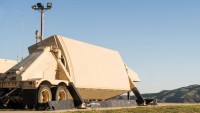China’s Largest Naval Drill Fails to stop South Korea Deploying THAAD; Japan to also Operate THAAD
| Arthur Dominic Villasanta | | Nov 29, 2016 08:53 PM EST |
(Photo : US Army) A THAAD missile system on its mobile launcher and what the system can do.
China held the largest ever naval exercise involving all the three fleets of its the People's Liberation Army Navy (PLAN) last September in a failed effort to scare South Korea into changing its decision to deploy the United States' THAAD (Terminal High Altitude Area Defense) system on its soil in 2017.
Like Us on Facebook
Japan also announced it has taken the first steps in a process that will eventually lead to its deploying THAAD on Japanese soil, a decision China will ferociously oppose.
On Nov. 14, Seoul announced its decision to speed-up the deployment of THAAD instead of being cowed by the unabashed show of force by the People's Liberation Army Navy Surface Force (PLANSF) that combined warships from all its three fleets -- the South Sea, East Sea and North Sea Fleets.
PLANSF held its joint surface exercise that involved live ammunition firings at the Yellow Sea and Bohai Sea. Over 100 surface warships of the PLANSF took part in the drill intended to frighten South Korea into submissiveness along with dozens of warplanes from the PLAN and the People's Liberation Army Air Force (PLAAF).
The drill last September was the third large-scale PLAN exercise over the past four months intended to scare South Korea. PLAN held two other drills in the South and East China seas in July and August, which were revealed to media, unlike the drill last September revealed only yesterday.
A Chinese military analyst told Chinese state-controlled media the reason for the secrecy was to exert enough pressure to get South Korea to change its mind without going too far. At the time of the secret naval drill, the South Korean government had still not made up its mind on whether or not to deploy THAAD. The analyst said China wanted to scare South Korea into not deploying THAAD.
The decision, however, was clinched in November with South Korea and the United States making separate announcements confirming the deployment of THAAD. The first of two THAAD systems should become operational by September 2017.
South Korea wants THAAD to defend against the real strategic threat posed by North Korea's expanding arsenal of ballistic nuclear missiles. North Korea claims it now has the capability to arm these missiles with nuclear warheads. South Korea has no home grown defense against ballistic missiles.
Japan early this week announced it had established a commission to examine the potential benefits of emplacing THAAD on its soil to increase its defense capabilities against North Korean ballistic missiles.
The commission headed by State Minister of Defense Kenji Wakamiya will examine the pros and cons of using THAAD.
"We are investigating future systems for intercepting missiles," said Japan's Defense Minister Tomomi Inada.
Although Japan has no concrete plans to deploy THAAD, the Japan Self-Defense Force is considering what can be done to better defend Japan from the threat posed by North Korea's ballistic missiles.
Japan is seriously considering a three-stage THAAD defense system. The first-stage consists of an anti-ballsitic missile defense system now in place is a two-tier system relying on ship-based RIM-161 Standard Missile 3 (SM-3) interceptors aboard its Atago-class and Kongo-class guided missile destroyers to target missiles in space.
The second-stage consists of land-based MIM-104F Patriot (PAC-3) surface-to-air missile batteries to intercept rockets flying close to the ground.
THAAD will allow the interception of missiles in or outside the Earth's atmosphere, thereby constituting a third-stage defense.
Tagschina, South Korea, naval drill, THAAD, Terminal High Altitude Area Defense, People's Liberation Army Navy, south sea, East Sea and North Sea Fleets, Japan, People's Liberation Army Navy Surface Force
©2015 Chinatopix All rights reserved. Do not reproduce without permission
 US THAAD Missile Battery to South Korea will be Ready for Action within 10 Months, says USFK Commander
US THAAD Missile Battery to South Korea will be Ready for Action within 10 Months, says USFK Commander China and Russia Continue Blasting US for THAAD Deployment to South Korea
China and Russia Continue Blasting US for THAAD Deployment to South Korea China Again Warns of Action Against THAAD; Might go Ahead with Joint Defense with Russia
China Again Warns of Action Against THAAD; Might go Ahead with Joint Defense with Russia China and Russia Oppose US THAAD Deployment to South Korea
China and Russia Oppose US THAAD Deployment to South Korea
EDITOR'S PICKS
-

Did the Trump administration just announce plans for a trade war with ‘hostile’ China and Russia?
-

US Senate passes Taiwan travel bill slammed by China
-

As Yan Sihong’s family grieves, here are other Chinese students who went missing abroad. Some have never been found
-

Beijing blasts Western critics who ‘smear China’ with the term sharp power
-

China Envoy Seeks to Defuse Tensions With U.S. as a Trade War Brews
-

Singapore's Deputy PM Provides Bitcoin Vote of Confidence Amid China's Blanket Bans
-

China warns investors over risks in overseas virtual currency trading
-

Chinese government most trustworthy: survey
-

Kashima Antlers On Course For Back-To-Back Titles
MOST POPULAR
LATEST NEWS
Zhou Yongkang: China's Former Security Chief Sentenced to Life in Prison

China's former Chief of the Ministry of Public Security, Zhou Yongkang, has been given a life sentence after he was found guilty of abusing his office, bribery and deliberately ... Full Article
TRENDING STORY

China Pork Prices Expected to Stabilize As The Supplies Recover

Elephone P9000 Smartphone is now on Sale on Amazon India

There's a Big Chance Cliffhangers Won't Still Be Resolved When Grey's Anatomy Season 13 Returns

Supreme Court Ruled on Samsung vs Apple Dispute for Patent Infringement

Microsoft Surface Pro 5 Rumors and Release Date: What is the Latest?










